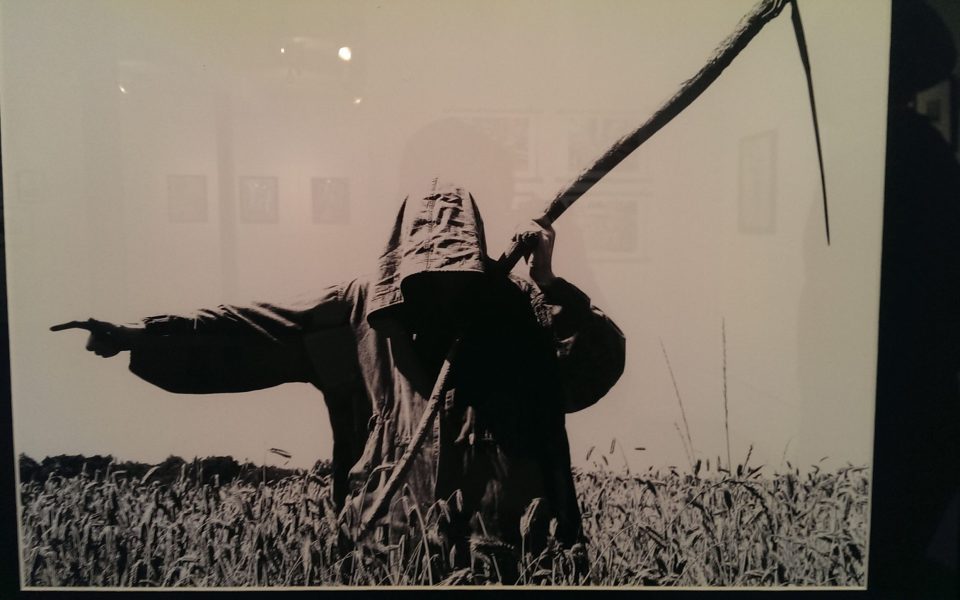by Sayaka Matsuoka
like the first surviving photograph taken by Nicéphore Niépce, Joshua Black’s crisp black-and-white photographs capture quintessential cityscapes. The lines of the buildings coupled with the reflections in the windows and scenes framed through iron fences give viewers new lenses through which to admire their city. His works of Winston-Salem confirm his love for the Twin City with every chosen detail.
When photography was invented in the early 1800s, enthusiasts used the breakthrough instrument for documentary purposes. As time passed, photography was elevated to an art form and those practicing it became recognized as artists. LightNoise, a new exhibition at the Delurk Gallery in Winston-Salem, serves as a sort of timeline through the development of the art of the photograph.
A wide array of shots, both black-and-white and in color, adorn the painted brick walls of the gallery in its first photographic exhibition. Everything from old, decrepit buildings to human forms hang in the space. Although the medium is the same, artists depict various subjects and themes in both traditional and inventive ways. Straightforward still-life images and landscapes line up next to surreal impressions, blurred and abstract.
Matt Schmidt approaches the medium with an experimental style. His photographs engage models to create close-up, cropped images of the female form. Schmidt’s shots highlight the curves of women’s bodies cast in light and shadow, creating a beautiful interpretation of sensuality.
Still others in the exhibition borrow from impressionists and expressionists like Claude Monet or Edvard Munch.
Christine Templeton’s “Impressions of Spring” and “Must Be a Light Leak” blur the lines between reality and the surreal, making almost abstract photos that urge the viewer to take up an interpretation.
Less straightforward than many of the other works in the gallery, Templeton borrows elements from the Photo Secessionist movement made famous by greats like Alfred Stieglitz, who argued that the significance of a photograph wasn’t about what was in front of the camera but rather what the photographers decided to depict and how they manipulated the images to achieve their own subjective visions. Victoria Vassar’s “Nature’s Scream” directly alludes to the famous expressionistic painting by Edvard Munch, “The Scream.” Her homage visualizes similar flowing forms — like the face of the off-putting character in Munch’s painting — as it closes in and abstracts the undulating lines, like those found in tree trunks or moving water.
Engaging with styles from more recent movements, artists like Annie Laura’s “Grounded Still” and Dualat Dawn’s “Elemental Vectorian Bath” craft surrealistic elements into their images. While Laura depicts a collage-like mannequin sprouting a wing on its right side, Dawn takes the image of a woman standing in a pool of water and infuses the pattern of a blue, cloud-scattered sky into her body. Both pieces let viewers peek into other realms, teasing out fantastical imagery transposed onto real, familiar objects.
Further along the walls, Mitch Tilley’s “Grimm” and “Daddy’s Got a Gun” look as if they’ve been plucked directly from a series of movie stills. Existing between reality and fantasy, these images delve further into the notion that photographers manipulate and direct what gets captured on film. In “Grimm,” a hooded, faceless figure stands in the middle of a field, pointing to the left while holding a scythe, alluding imagery from older horror films like Children of the Corn.
In the era of the often thoughtless and throwaway photography of Snapchat and Instagram, LightNoise is a refreshing look at both old and new creative ways to use the long-standing medium. Nicéphore Niépce would be proud.
LightNoise will be on display at Delurk Gallery (W-S) until March 29. Visit delurkgallery.com for more info.
Join the First Amendment Society, a membership that goes directly to funding TCB‘s newsroom.
We believe that reporting can save the world.
The TCB First Amendment Society recognizes the vital role of a free, unfettered press with a bundling of local experiences designed to build community, and unique engagements with our newsroom that will help you understand, and shape, local journalism’s critical role in uplifting the people in our cities.
All revenue goes directly into the newsroom as reporters’ salaries and freelance commissions.


Well done! I’m in this show and sold two pieces. Great crowd at opening night — inspiring to see so many great works and such interest!
Thank you for a great article and providing the opportunity for artist to have the spotlight!